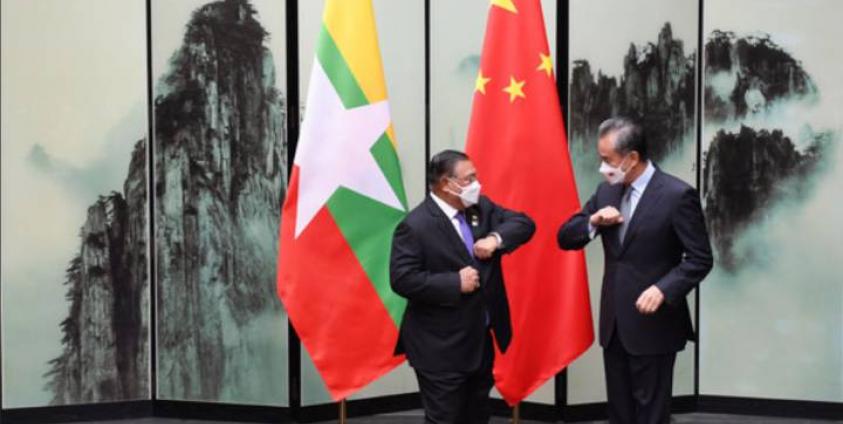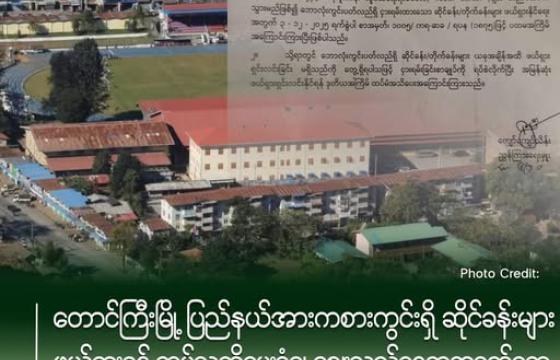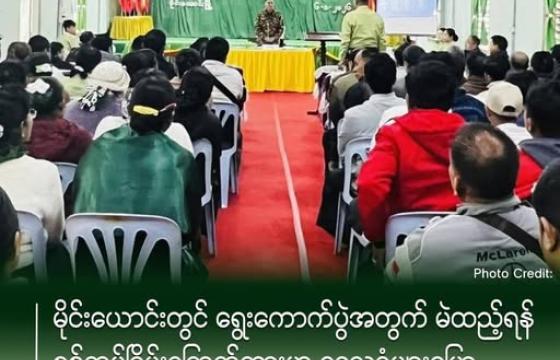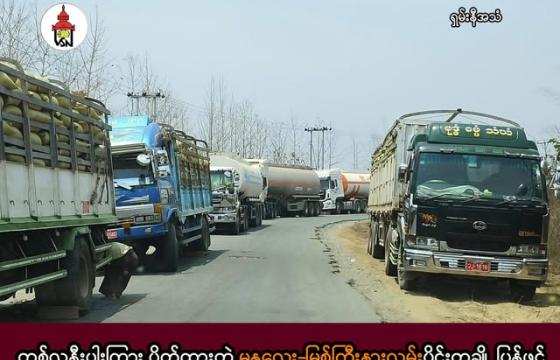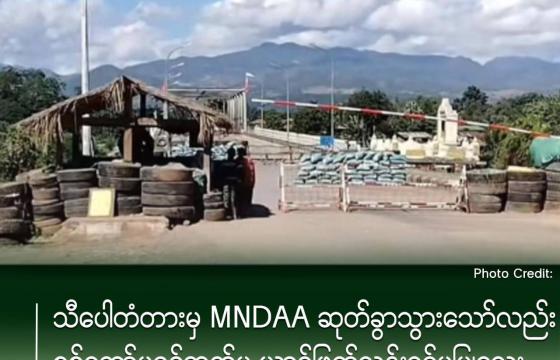Sai Wansai — On April 5 clashes broke out between the United Wa State Army (UWSA) and Restoration Council of Shan State (RCSS) near Thai-Shan border between Mong Hsat and Mong Ton, west of Tachilek in Mong Hta area, eastern Shan State at around 11 am, killing one UWSA member and five RCSS members.
However, the incidence was portrayed by UWSA and RCSS quite differently. Each blaming the others for the outbreak of armed clashes.
According to the UWSA, some 20 RCSS troops stormed a camp of UWSA manned by 18 of its soldiers in Mong Hta area, killing one and wounding four of its troopers, while five of the RCSS soldiers were also killed in action.
“They trespassed into our territory. We politely told them to withdraw. But they fired on one of our reconnaissance scouts. There were more than 20 of them. We had an exchange of fire and five of them were killed. We seized weapons, including M16s, M4s and machine guns,” according to Liaison officer San Pi of the southern UWSA, reported The Irrawaddy.
But according to Shan News, on April 5 the UWSA troops attacked RCSS troops in Mong Hta twice.
“At about 10 am the Wa started the offensive. The armed clashes lasted for about half an hour. Later another clash occurred again after 1 pm, resulting in two clashes within a day,” according to a Mong Hta local male relaying the incidence.
“Because of the Wa troops offensive there were armed clashes. From our side we lost 5 soldiers and some weapons and ammunition. Many Wa were also said to be killed but the details are still not yet known,” according to a high-ranking officer from RCSS who doesn’t want to be named told Shan News.
The RCSS has to withdraw from the northern Shan State at the end of 2021 and beginning of 2022 due to the onslaught of the Shan State Progress Party (SSPP), Ta’ang National Liberation Army (TNLA) and UWSA combined alliance force attacks. But the alliance pushed further into southern Shan State which resulted into the further south withdrawal of the RCSS to Thai border from territories in Loilem District, namely Mong Kung, Lai-Hka, Kyethi (Khesi) townships and Panglong Sub township, and from Taunggyi District of Lawkswak Township.
Shan news sources and RCSS insiders note that while the RCSS has dismantled many military garrisons and outposts in the north and south of Shan State, many of its members and functionaries are still in the areas, indicating they might be lying low and mingling with the local population as they are recruits from the respective local areas.
Reportedly, RCSS has said to have asked the Tatmadaw to stop the alliance force not to push further south, although if such request was really been made is unclear and cannot be verified. And at the same time, the RCSS is said to be gearing up to retake its lost grounds in southern Shan State, which is likely prompted the UWSA southern forces to try and disrupt by taking on the RCSS, observers speculated.
Tatmadaw reinforcing in southern Shan State
Meanwhile, the Burma Army or Tatmadaw is said to be reinforcing its troops in Lawksawk Township, according to the Shan News of April 8.
SAC Helicopter landing at Ayetharyar 8 April 2022
SAC Helicopter landing at Ayetharyar 8 April 2022
Following the failed discussion between the Tatmadaw and SSPP on March 30 concerning the former demand of the latter to withdraw from southern Shan State taken over from the RCSS, Tatmadaw has reinforced its deployment in Lawkswak, southern Shan State, with four jet fighters to Bahtoo garrison.
“The day before yesterday two and yesterday another two altogether four jet fighters are now stationed in Bahtoo garrision. In addition reconnaissance flights twice a day are being conducted sometimes in the direction of Pekon and sometimes near the SSPP and its allied force locations,” said a local male from Lawkswak Township, Intaw Town to Shan News.
On April 1, China said that it will support Myanmar’s military government “no matter how the situation changes” in the country over the coming months and years.
The Chinese Foreign Minister told his Myanmar counterpart Wunna Maung Lwin that Beijing “has always placed Myanmar in an important position in its neighborly diplomacy” and wants to “deepen exchanges and cooperation.”
After the meeting, Wang Yi and Wunna Maung Lwin inaugurated the new “Myanmar” consulate in Chongqing as a sign of greater diplomatic cooperation between the junta and China, according to Frontier Myanmar.
Chinese press release issued after the visit states that “[n]o matter how the situation changes, China will always support Myanmar in safeguarding sovereignty, independence and territorial integrity and exploring a development path.”
“China hoped the junta would help solve ASEAN’s issues with China over the South China Sea – in other words, that the junta will take China’s side and (like Cambodia has in the past) stonewall any efforts by ASEAN to push back against Beijing’s increasing domination of the contested waters,” writes an analysis in Council on Foreign Relations, on April 4.
The piece in its conclusion also points out, “As with Putin, Beijing no longer seems to care at all about how it is perceived regionally or internationally, and instead is fully backing autocrats.”
Analysis
The military situation development in Shan State, particularly the inter-ethnic conflict between the TNLA/UWSA and RCSS; and brotherly war between SSPP and RCSS are generally seen as a proxy war to push the RCSS out of northern Shan State, to protect China’s economic interest in the region.
The further southward push driving the RCSS from its southern Shan State operational areas seems to have an ambition to contain RCSS to the Thai-Shan border, or even to annihilate it.
If this is the case, the alliance of SSPP/UWSA may become more than the proxies to protect China’s business interest but a bigger scheme of autocracy versus democracy, which until now has been labeled as Cold-War-like conflict on global scale.
China’s legitimacy endorsement of the junta’s State Administration Council recently may be a pointer that it is moving in this direction.
In that sense the Burmese junta and the seven-member Federal Political Negotiation and Consultative Committee (FPNCC) should be under one blanket with China looking over. But the out of line Kachin Independence Army (KIA), Arakan Army (AA), TNLA, and Myanmar National Democratic Alliance Army (MNDAA) or Kokang, National Democratic Alliance Army (NDAA) or Mongla, and UWSA each in its own way have their own agenda and cannot be taken as a solid united alliance within the FPNCC and act in unison.
KIA is actively combating the junta and seems to be near to the junta’s opposition National Unity Government (NUG); AA has its own agenda of an independent state or confederacy; TNLA seems accommodating to NUG but wants to be close to UWSA; MNDAA is determined to regain its Kokang region from the junta’s installed local administration; and Mongla and UWSA have no intention to be on war-footing with the junta, even if they may be supplying arms to the other ethnic armed groups fighting the junta.
Besides, the junta is poised to attack the SSPP, also a FPNCC member, if the latter does not comply to the former demand of withdrawal from southern Shan State territories, which it has wrestled from the RCSS.
In short, the Shan State political and military situation is so complex and convoluted, we won’t be able to determine whether it is just purely a proxy war to safeguard China’s business interest or it is fast becoming part of global conflict pattern of autocracy versus democracy.


